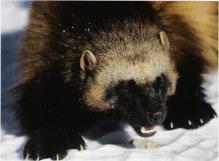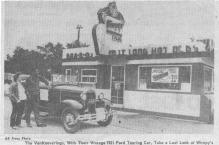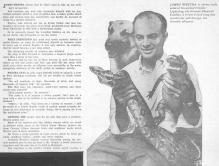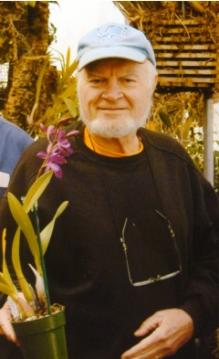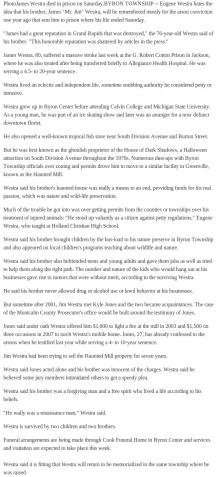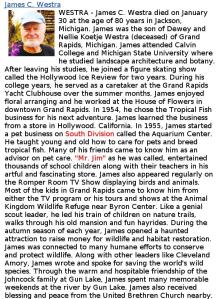-W-

Wolverine
Godwin Wolverines
Wolverine State
Walbridge Trailer Park.
Wimpy's
History of West Godwin
James Westra - pet shop owner
Wyoming - city
Wyoming Library Heritage Room
Wyoming Library
- Wolverine -

|
So what is a wolverine? Michigan is the wolverine state, and Godwin
students were the "Fighting Wolverines" in less political times.
They were largely exterminated in Michigan by 1900,
and perhaps considerably before that. The information below indicates
why any sports team might feel complemented by being called one.
Wolverines are basically your weasel from Hades. About the only North
American animal they give a wide berth is the grizzly bear. In today's
somewhat more environmentally conscious world it seems odd in some ways
that one would have a state animal that is for all practical purposes
extinct. But then California has a grizzly bear on its state flag, and
the last one was shot in 1916, somewhere around Los Angeles, while trying
to "rob" a bee hive. Following this approach, perhaps
Montana, Wyoming, or some other fossil rich state could put the dinosaur
on its flag as its state animal.....
Dick Speas, class of 1948, mentions that Frank Rackett obtained a wolverine
for his collection sometime after World War I, and commented that
it "was one of the last of its breed and very rare." ( An aside, this
desire to collect rare specimens is often what pushes species into
extinction - be it mounted specimens, or animal parts, as in rhino horns,
rare cat coats, etc. ) Dick also mentions a homing pigeon from World War I
that was obtained from the Smithsonian, suggesting that Frank Rackett
perhaps had global sources of specimens. The question of whether the
wolverine he obtained was from Michigan, and hence at odds with what is
said above, does not have a clear answer yet. Saying that the animal was very rare would
be consistent with its status in Michigan at the time. Only after an animal
has not been seen for a period of time ( 50 years is commonly used ) can it be declared extinct, if
only locally - it's not possible to prove there are none in the wild.
|
But as the piece below shows, a wolverine ocassionally makes a five mile
crossing to Michigan from Canada. How long it lives depends on whether it
crosses paths with someone with a gun. In any case, an animal legnedary for
its stamina clearly does ocassionaly make it in to Michigan yet, and
but for legions of people with firearms, looking for any reason to draw
blood, would probably reinhabit the state.
Left click on the images below for larger versions.

- Godwin Wolverines.
So how did Godwin students become known as the Wolverines?
Left click on the image below for a larger version.

Charles Saur did mention that "Acorn" most likely came from all the oak tress that
once inhabited the northeast corner of Division Aveneue and 36th Street. Photos of
the one room schoolhouse confirm many oaks in the area. The last of them were in
front of the libary building, and blew down in 2011, the last living link with the
original school property.
- Wolverine State -
So how did Michigan become known as the Wolverine State? Read on.
"Wolverine" nickname wasn't a compliment.
Michigan received its nickname "the wolverine state" from the residents
of Ohio ("Wolverine sighting in Thumb shocks wildlife experts," Press,
Feb. 26), When Michigan applied for statehood in 1836, our southern
border extended south of Toledo.
The governor of Ohio asked President Jackson to have the border changed
so that Toledo could become part of Ohio. When President Jackson agreed,
our territorial governor declared war on Ohio. This skirmish was called
the Toledo War.
Michigan was denied entry into the United States in 1836 because we were
at war with the state of Ohio. The residents of Ohio complained that the
people of Michigan were as "mean as wolverines." Michigan refused to
give in until President Jackson offered part of the Wisconsin Territory
(the Upper Peninsula) in exchange for the town of Toledo.
Michigan became a state in 1837 and the people were proud of a nickname
that was meant to be derogatory.

- Walbridge Trailer Park -
Between 34th Street (North Godwin is on the corner of 34th Street and Buchanan)
and 33rd street, on the west side of Division Avenue, was the Walbridge trailer
park.
A farm house was on Division Avenue, just north of 34th Street.
Robert A. McDonald, class of 1943, relates that the house was referred to
as the Godwin house by kids in the 1930s. An 1876 plat map of Wyoming does
show a house in just about the location of the farm house, and it's possible
that this was the house owned by Augustine Godwin.
An 1855 plat map shows that W. R. Godwin owned the land that Augustine
Godwin later owned, and in addition owned a big piece of land north of
what would become 34th Street, possibly as far north as what is now
32nd Street. The plat map also indicates a house about where
the farm on Division Avenue was located, adding to the notion that this was
the Godwin family house.
There was also something
called the Godwin hotel in the area, and perhaps on the Godwin property.
Details of this are vague at present, and maps do not indicate where
it was located.
In the 1940's yet there was a barn behind the house, and a baseball field behind
the barn. Continuing west, next came the interurban track, which was a high mound of earth,
with trenches on either side. Reflecting the construction,
dirt was taken from both sides of the right of way and used to raise
the center to make the track level. Further west there was an open piece
of land between the interurban track and Buchanan Street, which was covered
with small oak trees. This piece of land is now occupied by North Godwin
elementary. West of Buchanan Street. Between Buchanan Street and the
Grand Rapids and Indiana railroad tracks
was a parcel of woods known to people in the 1930's as the Buchanan woods.
But this was not part of the Godwin property, instead belonging to a
Cyrus Jones.
The barn disappeared some time between about 1948 and 1950, as well as
the baseball field behind it.
The Wallbridge Trailer Park appeared some time in the 1930s.
Robert A. McDonald's wife lived in the park, as did many other Godwin
Students. Relatives of his lived in the farm house in the 1920s.
By 1954 the farmhouse had burned to the ground, and the trailer park had been
cleared out. North Godwin was completed in 1954, in time for the 1954/1955
school year, and consisted of the gym and kitchen, the office, and
classrooms along 34th Street. An early discount store, Arlan's, was erected
on the corner of 34th Street and Division Avenue. This too is long gone.

- Wimpy's -
Left click on the images below for larger versions.
The photo at the left, above, was taken in 1956.
Wimpy's was long an institution on the 39th block of Division Ave. For
the first 15 years of its existence it was paired with the Southlawn theater,
where many a Godwin student would enjoy some Wimpy's fair etiher before ore
after a movie. It was an era when people routinely sat on stools at a diner
and merrily consumed their fare while sitting next to relative strangers.
But there was something of a family atmosphere at Wimpy's too, since in the
tradtion of the times many of the restaurants along Division Avenue in the
Godwin area were owned and operated by members of the community, and frequented
by people who lived in the area. This aspect of dinning out is largely gone
in year 2005.
Mike Bloore, class of 1955, worked at Wimpy's, as a curb hop. Perhaps as a
precaution, the curb hops were all male. Mike says:
"I actually worked at Wimpy's as a "curb hop" in the early Fifties (You may
not be aware that Wimpy's only employed males as curb hops on the back side
of the restaurant where drive-in service was offered.) Then later (1954)
moved to the Here 'Tis as a cook, where the curb hops were all
girls - much more enjoyable!"
Wimpy's 10-Stool Diner to Move
After 37 Years, a Parking Lot - By Ralph Truax, G. R. Press
A Grand Rapids Landmark, bearing the patina of 37 years, will soon disappear from the scene to make way for - you guessed it!- a parking lot.
Wimpy's Hamburg Inn, which has been at its 3961 Division Ave. S. location since 1935, will soon be torn down to provide parking for a new Burger King restaurant.
Mr. & Mrs. James M. VanKoevering Jr., who have owned Wimpy's about a year, will be moving the business into a remodeled building they have purchased at 3120 s. Division. The VanKoeverings say that, while the business may not be at its long-time location, the original "specialties of the house," Wimpy hamburgers and foot-long chili hot-dogs, will continue to dominate the menu.
The new restaurant will also seat more customers. The capacity will be at least double the 10 counter stools in the original eatery.
A couple of generations of Grand Rapids people, southenders in particular, bear some nostalgic memories of the little Wimpy's diner.
Alfred J. Potter, who is now associated with the Westdale Col. realty firm here, started the business in 1935 - midway in the depression-when he bought a street-car from the platters of Home Acres and put it on the lot just south of where it now stands.
Potter, who was then doorman at the Morton House, had saved up $125 in tips and this he spent on the little streetcar diner - $60 for the streetcar and the remainder to lease the lot for a year. It cost him another $80 to move the street-car to the Division Ave. location, he recalls.
"My father, Frank, and mother, Alphonsine - everyone who came in the diner called her "Mom" - ran the restaurant for me. We cut out the back of the car and built on a kitchen," Potter recalls.
The streetcar-diner reposed at this site for almost three years. In 1937, with the lease running out and the owner of the lot wanting more rent, Potter was approached one day by Adrian VanderEst, a Realtor. who owned the lot next door-the present address. VanderEst made Potter and offer to sell him the lot for $1,800, with $10 down and $10 a month.
"The offer was too good to turn down," says Potter, "so we moved the car next door, and there it has stood ever since."
In 1954 Potter bought a prefabricated diner from a firm in Topeka, Kan., one of the early makers of modular buildings. It was moved here on a truck and is the same building now occupying the site.
Potter recalls he was the originator of the foot-long hot-dog in 1937. Michigan Bakery was then furnishing him with hot-dog buns and consented to try its hand at making a bun to accommodate the long wieners. They had to be hand made, but the effort proved a success.
At one time Potter owned 62 restaurants. He was the originator of the Chicky Drive-In. He sold Wimpy's some 11 years ago to Ralph Goldner, who operated it for about 10 years.
Left click on the image below for a larger version.

Located at 3120 South Division, the photograph above shows Winpy's in 1974. Who owned
it, and how long it continued in business are not known here.
Material provided in part by Lee (Tanner) Collins, Class of 1941.

- History of West Godwin _
The author of the history of West Godwin shown below is not known. It
borrows from a history written by Mrs. Harriet Cutler Richards, a Godwin
teacher who retired in 1941. Whether the original history still exists is
not known, but at least it is now clear that there was one.
The first third of the document is an interesting summary of the history of the
Godwin system up through about 1949. The area served by Godwin up until about
1920 appears to have been primarily a farming community. After that,
"development" of the area appears to have been rapid, and there was a
continual shortage of classroom space. Starting with West Godwin, in about
1950, two more elementary schools were added soon after. The initial
phase of North Godwin, consisting of about 10 classrooms, a gym, kitchen,
and office, was completed in time for the 1954/1955 school year. South
Godwin was added around the same time. The Fisher Body Plant, and the
peculiar aspects of school funding in Michigan, made for a lush tax base
from the 1950s on, and opened the way for lavish spending up to the
present day.
HISTORY OF WEST GODWIN ELEMENTARY SCHOOL
The first school in the Godwin District was located at Clyde Park and
Allen Road. Because of this fact your historian would like to begin this
history with excerpts from history of the Fractional School District Number
6 of the Townships of Paris and Wyoming written by Harriet Cutler Richards
and presented to the Parent Teacher Association of Godwin School. Mrs.
Harriet Richards was a faculty member of the Godwin Heights Public Schools
for many years, retiring in June of 1941. It seems very appropriate to
start the West Godwin Elementary School History with these interesting facts
compiled by Mrs. Richards.
This district was named after Augustine Godwin, who came from Maine in an ox
cart at the age of three with his parents. They settled first at
Grandville, at that time, about 1832, a mere trading post. Later they took
up 160 acres of land from the Government in Wyoming Township on South
Division Road, and built a log house under the oaks on the farm now occupied
by the Godwin Heights and Division Avenue Lumber Companies.
Augustine Godwin served on the School Board almost continuously.
The first schoolhouse which served the communities now known as Rogers School and Godwin Heights School respectfully, was built on
the southeast corner of Clyde Park and Allen Road, West, now named 36th Street. It was located on land owned by Jacob Rogers, who
was deeded a quarter section by the United States Government in 1847.
The schoolhouse was built by a Mr. Potter, and may be described as a long, low, one room building made of rough boards just as
they come from the saw mill. The only boards that were planed were those in the desks, the seats, and the window casings. And
if, in imagination, we were to look inside, we would do doubt find the traditional straight backed benches for seats, a large
oblong box-like stove, with a circular drum above it to radiate more heat. And if it should be a cold winter morning, we would
see a circle of pupils standing around the stove getting warm; for the corners away from the stove are not warm enough to be
comfortable. Shelves have been placed on the front walls on either side of the entrance for the pupils dinner pails, and pegs
along the side for coats and caps.
Let us look in one corner near the door. On a stool, or more likely a block of wood, will be the proverbial water-pail, with
dipper in it and sometime during the session some boy or girl will ask permission to "Pass the water" - a coveted privilege. The
water has probably been carried from the nearest house, perhaps a quarter of a mile away.
The boards of the floor are knotty and rough. Charles Rogers, son of Jacob Rogers, was the first director of the school, and as
he went with his little daughter on her first day of school, he carried an adz. In answer to her question, as to why he carried
the tool, he said he would hew off the knots in the floor, so the teacher would not stub her toe and fall. The first teacher was
Roxanna Shafer.
Pg 1 - continued
The schoolhouse was later moved across the road, but was finally abandoned when the patrons of the school thought it inadequate to
supply the needs of the district. They wanted a more central location.
Division Avenue had become a well known thoroughfare where the stagecoaches had been traveling over the plank road between Grand
Rapids and Kalamazoo. Taverns had been built all along the way to accommodate the travelers, and also to rest or change horses.
The nearest and best known to us was the one at Kelloggsville, a famous landmark and the scene of many exciting events, and the
Godwin House or Hotel which was built about 1865 on the Godwin Farm, replacing the log house built under the oaks previously
mentioned in this history. There were tollgates too, for anyone driving on the road must pay toll. There was one on the corner
where Mr. Rackett's house stands at 36th Street and Division, only further out in the road; also one near the Kelloggsville
Tavern. With the building at the Grand Rapids and Indiana (now Pennsylvania) railway, the stagecoaches ceased to be used, so the
tollgates or toll houses were abandoned and later moved away.
On April 27, in the year 1867, the joint board of school inspectors of Paris and Wyoming, with Augustine Godwin, Chairman, met in
the Godwin Hotel and formed the School District to be known as the Fractional School District No. 6 of Paris and Wyoming Townships
and embracing the following territory::: - I quote from the records; -
All of section 18; N3/4 of Sec. 19; also S1/4 of S.E. 1/4 of Sec. 19; N.W. 1/4 Sec. 20; and S.W. 1/4 of Sec. 17 of Paris Township
and all of Sec. 13; E 1/2 Sec. 14; N 1/2 of Sec. 24; and N 1/2 of S.E. 1/4 of Sec. 24 of Wyoming Township. (This includes much of
what is now the Rogers District.)
The voters met on the 6th day of May, 1867 at the Godwin House for the purpose of electing officers. These officers called a
special meeting May 21, 1867 at the Godwin House. They voted unanimously to build a schoolhouse that summer and it was to be
located on one of the four corners by the old toll gate. The cost of the building was not to exceed fifteen hundred dollars
($1500.00). They chose the present site, it being the Northeast corner, and purchased the land from Riley Cole, agreeing to pay
him the sum of seventy-five dollars ($75.00).
He was hired to clear the grounds and build an inside fence 4-1/2 feet high with cedar posts to be 6 inches wide, laid 3 inches
apart. He was instructed to leave all the shade trees standing, and have it all done within two weeks.
The building was to be of brick, and the brick, stone, sand and lumber were hauled and work begun by the middle of June. George
Kenyon was engaged to build the schoolhouse. They provided for drinking water and paid Davis Laraway fifteen dollars for digging
and bricking up a well.
Pg 2 - continued
On September 3, 1867, the first annual meeting of FR. School District No. 6 of Paris and Wyoming was held at the Godwin House, as
the schoolhouse was not completed. The most important business transacted was a vote to raise an additional $427.00) over and
above the ($1500.00) previously voted for the purpose of finishing the schoolhouse.
The schoolhouse was completed in time for the winter term of school which was taught by Charley Howard, who received a dollar a
day.
As the enrollment in the school seemed to increase considerably, the district board thought they could accommodate them better by
dividing the room into two parts. A partition was built and placed through the center of the building, thus making it a two room
school with two teachers.
Mr. Fred Bartels, father of our recent School Board Treasurer, Frank Bartels, built the partition and made it in sections so it
could easily be taken down whenever there were gatherings that required the use of both rooms. Mr. Fred Bartels was the moderator
of the District at this time, about 1909.
At the school meeting in July of 1923, it was voted to build an eight room school. A special meeting was called later. To
accommodate all these new children who enrolled in the following September, a Togan Stiles building was purchased and erected on
the school lot and an extra teacher was employed. This did not suffice and during the latter part of the year, a room was rented
at the new Kellogsville School and the Seventh and Eighth grades were transported there.
The new building was completed and ready for occupancy in January of 1925.
Mr. Charles Saur of Sparta was engaged as the Superintendent, with a staff of seven teachers. It was now a graded school covering
the first ten grades.
At the completion of the new building, the old two room school was razed. One part of it, however, is preserved, and that is the
corner stone of the new building which lay above the front door of the old building, and bore the date and district number.
The influx of families had continued so fast that it was necessary to build an addition to the school the next year. This was
placed on the north end of the building in 1925. It consisted of grade rooms on the first floor, a large session room across the
entire north end of the building on the second floor, with class rooms adjoining, and a gymnasium room in the basement.
Pg 3 - continued
The eleventh grade was added to the High School and more teachers were employed.
But still, this did not suffice, and the next year, 1926, an addition was built onto the south end of the first unit. This
addition included a library, an office for Mr. Saur, a kindergarten room and auditorium in the basement, besides session rooms for
the grades. This year the twelfth grade was added to the High School course, and Godwin was placed on the University list.
Again, the building could not accommodate the students as the attendance kept increasing so rapidly. So in 1929, a fine new high
school building was added to the system at a cost of $75,000.00.
A much needed addition to the system, or rather a real necessity, was a library building. In 1936 this was made possible through
the aid of the W.P.A., an organization established by the federal government because of the economic depression. The building
which cost $45,000.00 was not completed until the following year. The building also houses a large and valuable museum, in fact,
the largest of its kind in the country, prepared and donated to the school district by Frank Rackett.
Ten acres of land was purchased from Mr. Frank Rackett in 1935 and was developed as a W.P.A. project in 1936-67, with the Federal
Government contributing about $60,000.00 for the work. The playground includes the football field, six concrete tennis courts, a
swimming pool and facilities for a number of units for a modern athletic and recreational program.
Each year found the school in need of more room, especially for the grades.
To relieve this condition, the District voted to build an addition to the High School Building, and bonded the District
accordingly, to raise money. Work was begun in the spring of 1938 and in the fall, the Junior High Department moved into their
new quarters. This gave the old building over entirely to the use of the Elementary Department. And we find another addition
just completed and occupied at the opening of the school year, September 1941. This time the east end of the original High School
was extended.
(This concludes the excerpts from the History by Mrs. Harriet Cutler Richards).
Again the buildings were over crowded and plans were made for an addition.
Pg 4 - continued
In March, 1948, Superintendent Saur was instructed to give the Board a composite written report on the potential enrollment for
the next five years, along with his recommended plans for financing the planned addition to the existing building. Mr. George
Daverman and several contractors were consulted.
At a special Board Meeting, bids were read and considered. A general discussion was carried on by the Board regarding the
necessity of building one wing or two.
Mr. Vanderpool asked that the Board take immediate steps for a complete survey o the entire school system.
In December, 1948, Mr. Daverman was contacted and asked to secure bids for an eight room addition to the west wing of the High
School Building, the addition to include a sound proofed band room.
Superintendent Saur was instructed to write to the Department of Public Instruction at Lansing in regard to a survey in the
educational, administrative and maintenance departments at Godwin.
On March 17, 1949 a co-operative team of the following representatives: Wilfred E. Clapp, from the State Department of Public
Instruction, Fred A. Miller, from the University of Michigan, College of Education, and Ralph Wanrich(?), Vocation Education, made
a visit to Godwin High School as requested by the Godwin Heights Board of Education.
Mr. Clapp reported that it was apparent from the existing figures and from pre-school statistics that the District was facing
serious over crowding in its Elementary School and must do something about it. For example, there were 171 children for two
kindergarten rooms. The groups were so large that the program becomes a custodial program rather than a truly educational
program. The same may be said of the other grades.
Mr. Clapp stated that for some years there seemed to be a trend to build larger and larger buildings and to concentrate more and
more children on a central site often too small. Fortunately this trend has now definitely been reversed. It is now believed
that small children respond better to buildings which are rather small, informal and friendly. It is certainly good policy to
provide for elementary age children, a good building of their own. Designed especially for them rather than place these children
in a building with High School children.
Pg 5 - continued
All too often in the past, school districts have built new high school buildings and let the elementary children put up with
what is left. Godwin Heights should not make this mistake. We believe that it would be fundamentally unwise to add more room to
the existing high school plant, thereby moving the high school into the new rooms and providing more grade rooms on the first
floor of the high school building. There are already five grade rooms in the high school building.
Mr. Campbell and Mr. Clapp drove around the District accompanied by Superintendent Saur. There is an area on the west side of the
District approximately two miles from the present school building in which many houses have been constructed and many more will
apparently be constructed. Buses are now used to bring these children to the school building every day. A quick study of the
area seems to show that there is room for an elementary building in this area. This building should be located ation.
After the report concerning the survey and recommendations was read on April 1949, visiting citizens were permitted to express
their views on the subject. After considerable discussion it became apparent that all present favored immediate building
construction which would provide for the greatly increased enrollments expected in the next two years. However, some difference
of opinion existed among citizens present, as to the exact location for the building.
After all Board Members present had expressed their ideas on this question, President Smyth summarized the Board's position as
follows:
1. That immediate needs for additional school rooms prevents further delay and indecision, and that immediate action was
indicated and that this can be best accomplished by utilizing the present eight room addition plans and site.
2. That the prime locations suggested by the State Department representative was based on a snap survey and is not
sufficiently accurate for the Board to use for a site and location data.
3. That excessive delay would result from the necessary architectural work, site acquisition and financing plans to permit
building for immediate needs along the lines suggested by Mr. Clapp.
Pg 6 - continued
4. That the School Board will have prepared from the 1949 census data, a map showing the child’s age distribution in the
School District, and that in the near future, steps must be taken to start this project so that elementary buildings may be
erected in accordance with the state recommendations.
With the above considerations in mind, Mr. Hiner made the following motion: that Superintendent Saur be instructed to request Mr.
Daverman to secure bids immediately on the eight room addition to the East Wing of the High School Building as soon as the
approval of the plans is received from the Department of Public Instruction, the bids to include the time needed for construction.
On April 18, 1949, a group of citizens from the Clyde Park area presented the Board with a petition of approximately 150 signers.
The petition read as follows:
That an elementary school be constructed in the area of 36th Street and Clyde Park for the safety and convenience of the children
who reside in this fast growing, thickly populated area, instead of an addition to the present site. Considerable discussion was
held on the subject. No definite decision was reached.
Again on May 16, 1949, a number of residents from the Clyde Park area registered a protest against the proposed building
addition. They were in favor of building an elementary school in the vicinity of Clyde Park and 36th Street. The members of the
Board as a whole still felt that the proposed building addition must be built first in order that the children now ready for
school would not be deprived of full time education and not forced to attend on a part-time basis, which would be necessary if the
addition was not built without delay.
XXXXXXXXXXX
A motion was made by Mr. Hiner that the bid be awarded to the Beckering Construction Company, subject to the approval of the loan,
state approval of the plans, and to the representatives of the Boards of Approval in the meeting with the Beckering Construction
Company. The East Wing consisting of 8 rooms was added to the High School in 1949-50 at the approximate cost of $95,000.00.
Mr. Vanderpool made a motion that upon completion of the census, the Board take immediate steps to institute a survey of the
school district in the vicinity of Clyde Park and 36th Street, regarding the possible site for the location of an elementary
school building, the estimated cost of plans, and the possible means of financing same.
Pg7 - continued
Mr. Elwin Wissner served a petition on the Board, requesting a special meeting of the School District to consider and take action
upon a proposal to erect a new grade school at some suitable location in that part of the School District west of Clyde Park
Avenue. The meeting was held June 9, 1949.
At this special meeting, Mrs. Wissner made the motion that the following resolution be adopted by School District 6, Fr. Paris and
Wyoming Townships, Kent County, Michigan: Resolved that there is an immediate need for an elementary grade school building in that
part of the School District lying west of Clyde Park Avenue. Further resolved that the Board of Education be, and it hereby is
authorized and directed to take such action s it may deem necessary of advisable to acquire a suitable building site in such area,
to erect, equip and staff a suitable elementary grade school building and to provide for the necessary financing forthwith. The
vote was 129 yes; 39 no; and 20 spoiled ballots. (Ed. note: what does this mean exactly?).
Mrs. Dorothy Kedgecock, Stewart Vanderpool, and a committee of residents from the Clyde Park area were empowered to take options
on the property under consideration.
Surveyor Williams was authorized to make a boundary and contour survey of the parcel of land purchased for the new school
building. The site consists of approximately nine acres and is part of S.W. 1/4 Sec. 13, Town 6N, range 2N. The cost of site as
$7,900.00.
President Vanderpool appointed Mr. Dangl, and Mr. Hiner to act as a committee with Mr. Saur and the Clyde Park Building Committee.
The Board decided to raise the money by a bond issue. The amount to be raised was $175,000.00. The vote on increased tax
limitation of 6 mills from 1951-55 was unanimously carried on August 22, 1949. Prices submitted were on eight, ten and twelve
elementary school buildings plus a gymnasium. The period of usefulness of the property for which bonds were to be issued is fifty
years.
Preliminary sketches of the new buildings were accepted by the Board in November of 1949. The building will consist of ten rooms,
plus gymnasium.
The construction of the new building was retarded because the structural tile was not on hand. Late in November the tile
arrived. The tile cannot be applied during freezing weather, so there was another delay.
Pg8 - continued
The completion date of March 1, 1951 passed without the building being completed. An extension of contract time was granted to
the Osterink Construction Company with the complete understanding that the classrooms will be completed by September 1, 1951 and
the building will be ready for equipment by August 20, 1951.
(See minutes of Board Meeting August 8, 1949)
On August 6, a motion was made by Mrs. Evans, supported by Sonefeld, that the new elementary school at Clyde Park and 36th Street
be known as the "West Godwin Elementary School".
School opened in September, 1951. However, the building was not ready for final inspection until the following March. Inspection
by the Board Members, Superintendent Chambers, and representatives of the J & G Daverman Company was made March 31, 1952.
The attendance area was established tentatively as the area comprising the second voting district.
There were 303 pupils the first year.
Mr. Weldon Fraze acted as Elementary Principal at Godwin and West Godwin Schools.
The following teachers were employed:
Mrs. Eleanor Samyn Kindergarten
Mrs. Thelma Hamlin First Grade
Mrs. Bertha Plasman Second Grade
Mrs. Margaret Knudson Third Grade
Mrs. Lillian Poste Third & Fourth Grades
Mrs. Dorothy Richards Fourth Grade
Miss Marilyn Garfield Fifth Grade
Mr. LeRoy Kalrose Sixth Grade
Marjorie Van Reenan replaced Mrs. Heyboer in the spring of 1952. A motion was made to dedicate the West Godwin School to the
former Superintendent and his wife. The idea met with opposition among citizens in the community and was later abandoned.
An open meeting was held in the hall of the new West Godwin Building on October 4, 1951 at 7:45 p.m. for the purpose of organizing
a P.T.A. Ninety-one citizens were present.
Pg 9 - continued
Mrs. Betty Ford, President of Godwin P.T.A. called the meeting to order. Superintendent Chambers and Mr. Fraze, the Elementary
Principal gave short talks. Mrs. Vernon Black, Kent County Council P.T.A. President was introduced. She gave a short talk on the
history and objectives of the P.T.A. By-Laws were established.
A motion was made to have three members on the nominating committee.
A motion was made to start P.T.A. meetings on the third Thursday of each month.
A motion was made to start P.T.A. meetings in September.
A motion was made to make the annual dues fifty cents per person. All motions were carried.
Time was taken to pay dues and receive membership cards.
Mr. Ivan Small opened the meeting for nominations for P.T.A. officers from the floor.
The following officers were elected.
Mrs. Wesley Shusta President
Mrs. Jack Guelze Mother Vice-President
Mr. Philip Turnes Father Vice-President
Mrs. Eleanor Semyn Teacher Vice-President
Mrs. Robert Hill Recording Secretary
Mrs. Harold Root Corresponding Secretary
Mrs. Fred Wagner Treasurer
Mrs. Black installed the officers.
Committee Chairmen were as follows:
Program George Aprill
Membership Ray Corkins
Hospitaliity Mrs. Wesley Shusta/Miss Garfield
Publicity Mrs. Art Spurgat
Historian Mrs. Ford Robinett
Safety Robert E. Hill
First By-Laws of West Godwin P.T.A.
Pg10 - continued
There was a serious traffic and pedestrian problem in front of the school for several weeks. Mothers supervised the children
crossing the street for the first few days. President Coffman instructed Superintendent Chambers to make arrangements for school
custodians to supervise the children at the 36th Street and Clyde Park intersection until the traffic light has been installed and
the safety squad is also in operation. Superintendent Chambers reported later that it had not been practical to have school
custodians supervise the children at the traffic crossing. A supervisor for the intersection was secured.
The Road Commission agreed to level the shoulders along Clyde Park Avenue and 36th Street as requested by the Board. The speed
limit was reduced to 25 miles per hour.
A gravel walk was installed on the area of the proposed sidewalk along Clyde Park Avenue on the West Godwin property. Cross walks
were installed on all four sides of 36th Street and Clyde Park intersection and at Kenneth Street crossing.
A flasher unit was purchased to be used as children came to and from school.
Mr. Marvin DeVries was employed to lay out preliminary plans for West Godwin playground.
Mr. Goeman did the grading of the grounds necessary for the proper installation of the fence.
A chickenhouse belonging to Mrs. Fox had to be moved before the fence could be set in the proper location. The Board purchased
the chicken house from Mrs. Fox for $500.00. The building was moved to the West Godwin property to be used for storage space.
The fence was installed in late fall 1951 at the cost of $4,000.00.
A committee was appointed in November to revise the By-Laws with Mrs. Fred Heuschele as chairman, assisted by Miss Dorothy
Richards, Mrs. Thelma Hamlin and Mrs. Kenneth Sprik. The By-Laws were revised and adopted January 17, 1952. They were approved
February 19, 1952 and signed by Mrs. Moore. (A gavel was presented from Godwin P.T.A.).
Program committee assistants appointed in November were Mrs. Charles Dalenburg, Mrs. Peter Oudendyk and Miss Richards.
Mrs. Kenneth Sprik was appointed to assist on the Hospitality Committee.
Pg11- continued
Mrs. Richard Longcore was appointed telephone committee chairman in December.
Mr. George Aprill resigned as Program Chairman in December. Mr. Berson Bowen was later appointed as Program Chairman.
Health Committee appointed in January, was Mrs. Harold Walsmeer, Mrs. Clarence Sprik, and Mrs. Edward Dykstra.
The Nominating Committee appointed from the floor was Mrs. Richard Chipman, Mrs. L. Posto, and Mrs. Ed Dykstra. The Executive
Board appointed Philip Turnes as Chairman and Ray Corkins.
Mr. Hill resigned as Safety Chairman and in February, Peter Oudendyk, Fred Wagner, and Melvin May were appointed on the Safety
Committee.
The Auditing Committee appointed in May was Mrs. Wissner, Chairman, Mrs. Thelma Hamlin and Phyllis Baldinger.
Pg 12 - concluded
(Material provided by Lee (Tanner) Collins, Class of 1941. )

- James Westra - pet shop owner -
James Westra operated "Jungle Jim's Pet Store," on Division Avenue,
for many decades.
It was originally located on the east side of Division Avenue, at about
41st Street, and started business in about 1955. People there were very
tolerant of students coming in just to look, using the business as something
of a local zoo. A personal fantasy was to own a small alligator, which at
the time was about six dollars. Sometime later the business moved to
3815 Division Avenue.
Many of the animals sold, bought largely as curiosities, probably did
not meet a good end. Because of habitat loss, and a pet trade that leaves
many animals dead during the process of capture and transport, many of the
animals sold during the 1950s and 1960s are now very rare, and in some
cases almost extinct. People that bought many of the animals lost
interest in them, usually meaning the animal was doomed. So while a
amusing phenomena for many years, pet shops like the one James Westra
oprated cannot exist today, except for those animals that can be
successfully bred for this kind of commerce.
Left click on the images below for larger versions.

- Wyoming - city -
Left click on the image below for a larger version

In and around 1963 students from Godwin, and Kellogsville or Rogers, were allowed
to spend a day shadowing some of the Wyoming city officials as a way of seeing
government in action. Having been selected to spend a day with Paul Spelman,
city engineer, I got to see how a first rate city planner worked, including
visits to projects like the new pipeline to Lake Michigan, and a new treatment
plant. Considered a visionary, it's also said that the projects he worked on
were first class in every way. Quality. Value for the taxpayers. And built to
provide long years of service. Those projects are close to 45 years old now,
and one hears nothing of the maintenance problems so common today from projects
that were shoddily built with huge cost overruns. The municipal parking garage
on the SW corner of Fulton and Division for example. Built in about 1960, it was
falling apart the day construciton ended - whether anyone was ever taken to task
is unknow. An addition to the Ryerson Library is another example, torn down
not long after is was "completed." Again, the taxpayers are simply asked to pony
up again.
It's perhaps the biggest tribute to Paul Spelman that the projects he headed
continue to serve the Wyoming City community well in year 2008 and the
citizens never have to worry about them.
The photographs below are of the Wyoming, MI, area, in different years.
LeRoy Rockwell located the 35mm slides, taken by a professional photographer living
in the area, and had them printed for use here.
Left click on the images below for larger versions.
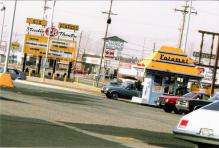
November, 1981.
|
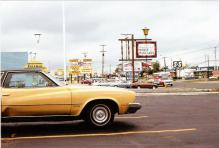
August, 1978.
|
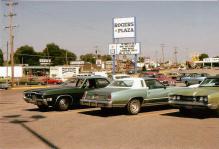
August, 1978.
|
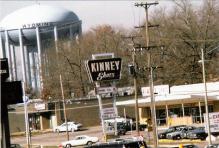
November, 1981.
|
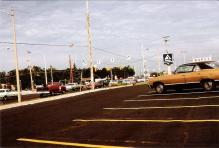
August, 1978.
|
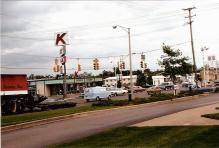
August, 1978.
|
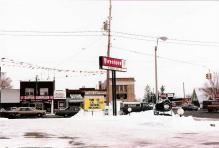
February 4, 1978.
|

July 10, 1977.
|
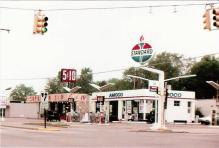
1977
|
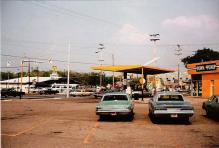
May 17, 1977
|
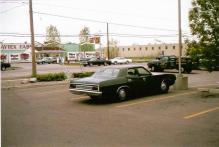
1977
|
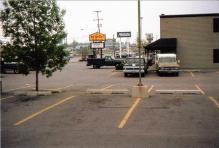
1977
|
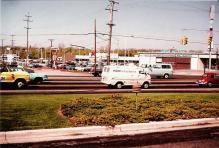
1977
|

1976
|
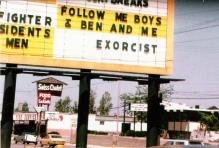
1976
|
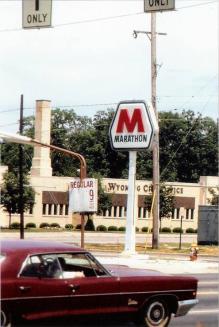
1976
|
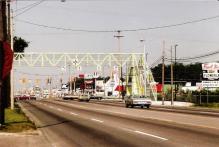
July 2, 1975.
|
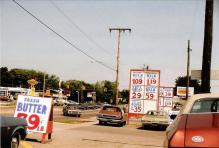
June 26, 1975.
|

1973
|

1976
|
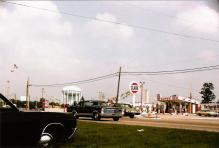
June 26_1975
|
Left click on the image below for a larger version.

Clyde Park & 44th. Looking NE. The building appears to have been a gas station at one time, but maybe a dwelling when photographed. The vehicles suggest
maybe 1940.

- Wyoming Library Heritage Room -
The wyoming library opened its Heritage Room in 1996. It now serves as
a repository for local memorabilia, including photographs, documents, and
annuals from the Godwin school system. Sadly, the collections are apparently
of more use to the Heritage Room staff than to the wider public. As often
happens with today's libraries, in their zeal to protect material library
staffs often effectively keep the material from the public, and are the
only ones to have useful access to it.
This is certainly the case with the Wyoming Historical Society Heritage
Room at present.
As of October, 2003, the operation is very resource
limited. Be sure to scan, or have scanned, any material you consider
donating. Once given to the Heritage Room, access to the material then
becomes too restricted to be of practical use.
Without better access, and adequate provisions
for making copies of material, donating material at present is equivalent
to taking it out of circulation, and can thus impede the efforts of others
rather than enhance them.
It is suggested that anyone having material of interest
loan or donate it to the Kentwood Historical Society, located at 4700
Kalamazoo Avenue. The public is encouraged to use the material for reserach
purposes, and access to the material is more realistic.

Material provided by Lee (Tanner) Collins, class of 1941.

- Wyoming Library -
Photographs of the outside of the new Wyoming library are shown below.
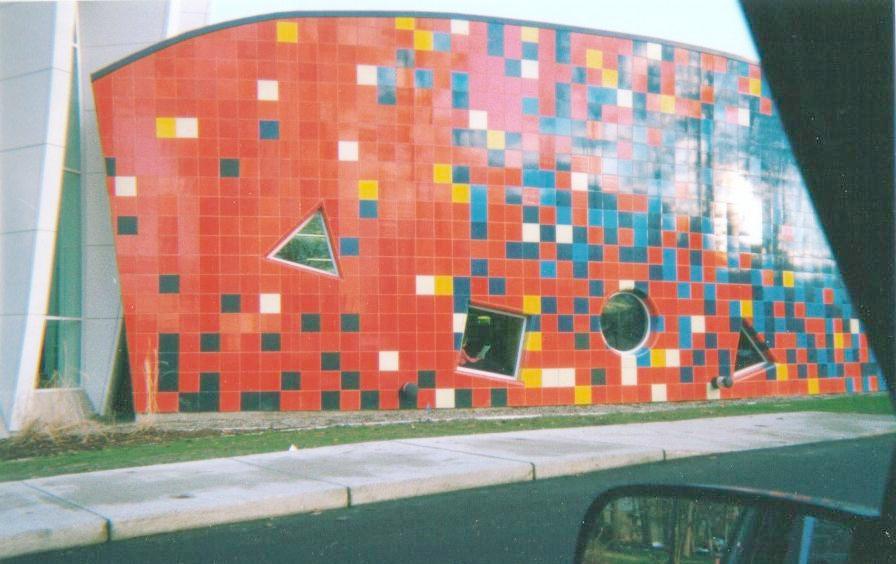

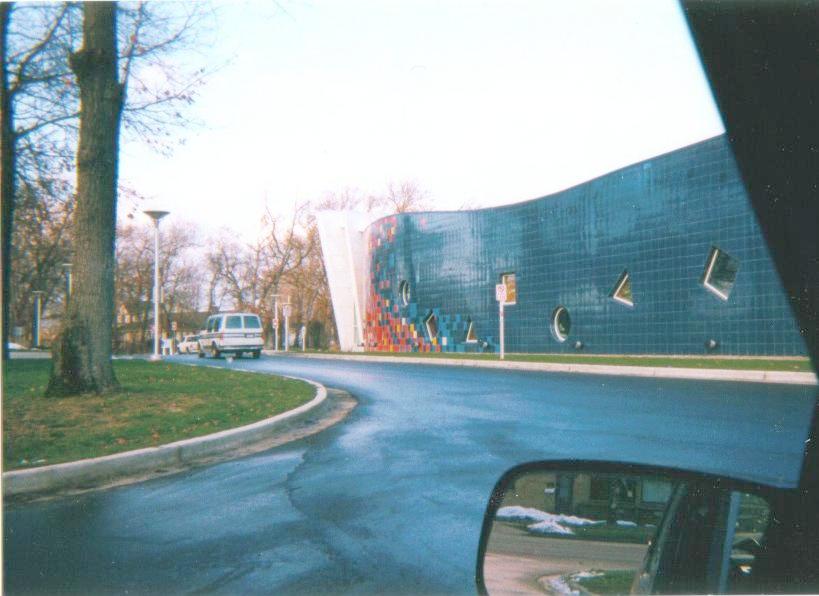
(Material provided by Lee (Tanner) Collins, Class of 1941. )





